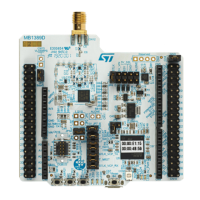RM0453 Rev 1 393/1461
RM0453 General-purpose I/Os (GPIO)
427
10 General-purpose I/Os (GPIO)
10.1 GPIO introduction
Each general-purpose I/O port has four 32-bit configuration registers (GPIOx_MODER,
GPIOx_OTYPER, GPIOx_OSPEEDR and GPIOx_PUPDR), two 32-bit data registers
(GPIOx_IDR and GPIOx_ODR) and one 32-bit set/reset register (GPIOx_BSRR).
All GPIOs have a 32-bit locking register (GPIOx_LCKR) and two 32-bit alternate function
selection registers (GPIOx_AFRH and GPIOx_AFRL).
10.2 GPIO main features
• Output states: push-pull or open drain + pull-up/down
• Output data from output data register (GPIOx_ODR) or peripheral (alternate function
output)
• Speed selection for each I/O
• Input states: floating, pull-up/down, analog
• Input data to input data register (GPIOx_IDR) or peripheral (alternate function input)
• Bit set and reset register (GPIOx_ BSRR) for bitwise write access to GPIOx_ODR
• Locking mechanism (GPIOx_LCKR) provided to freeze the I/O port configurations
• Analog function
• Alternate function selection registers
• Fast toggle capable of changing every two clock cycles
• Highly flexible pin multiplexing allowing the use of I/O pins as GPIOs or as one of
several peripheral functions
10.3 GPIO functional description
Subject to the specific hardware characteristics of each I/O port listed in the datasheet, each
port bit of GPIO ports can be individually configured by software in several modes listed
below:
• Input floating
• Input pull-up
• Input pull-down
• Analog
• Output open-drain with pull-up or pull-down capability
• Output push-pull with pull-up or pull-down capability
• Alternate function push-pull with pull-up or pull-down capability
• Alternate function open-drain with pull-up or pull-down capability
Each I/O port bit is freely programmable, however the I/O port registers must be accessed
as 32-bit words, half-words or bytes.

